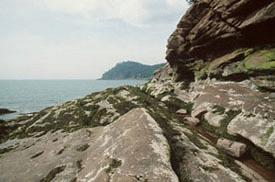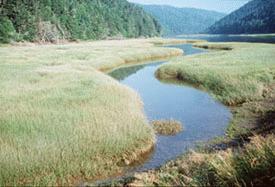
Marine coastal system
Fundy National Park
The intertidal zone-the part of the beach that lays between high and low tide-is brimming with life. The plants and animals here have to be hardy. They live in salt water at high tide. At low tide they live in the fresh water of rain or runoff, or they get completely dried out and baked in the sun. Temperatures can rise to over 30 degrees Celsius in the summer, or drop to minus 25 degrees Celsius in winter. Waves crash upon them, battering them and covering them with silt. Winter ice-cakes crush them. Yet life thrives here. In fact, an organism's tolerance to exposure dictates where species live in the intertidal zone.
Rocky Shores
On rocky shores brown seaweeds and barnacles (Balanus balanoides) find anchorage. Some of the animals living between boulders and cobbles are periwinkles (Littorina spp.), side swimmers, gumdrop sea-slugs (Onchidoris bilamellata), dog whelks (Thais lapillus), limpets (Acmaea testudinalis), butterfish and crabs.
Tidal Flats

Fundy is renowned for its vast tidal flats. The difference between the view of Alma Beach at high and low tide is dramatic. The Alma Beach tidal flat may extend more than one kilometre on a very low tide. Peculiar animals live in this thick mud substrate, especially mud shrimps (Corophium volutator), clams and a multitude of worms. The spectacular colours of the clam worm (Nereis virens) change from pink to brown to green iridescence. The bamboo worm lives in a vertical mud tube. These hidden organisms constitute a succulent feast for sandpipers and plovers in late summer migration through the Bay of Fundy.
Salt marsh
Above the normal high tide, but inundated regularly on very high tides, are salt marshes. The salt marsh at the mouth of the Upper Salmon River and those on the Point Wolfe and Goose Rivers are kept fertile and lush by the giant tides.

Ducks, geese, herons and other birds feed or nest near these marshes, or use them as migration stops. Fish (mummichog and threespine stickleback) forage and grow in the briny creeks, and smaller organisms prosper in the rich mud and marsh waters, where nutrients from the land and sea come together to produce excellent growing conditions. Water flowing out of the marshes carries plant and animal matter into the bay. This is a rich nutrition source for animals in the upper bay. The salt water cordgrass ( Spartina alterniflora) dominates this brackish ecosystem. This vigorous tough grass forms dense stands close to the water and does not mind being inundated occasionally. It has air passages in the stem that permit the transportation of oxygen to the often submerged roots, while glands excrete excess salt. The roots and rhizomes help prevent erosion.
In most ecosystems, the food chain begins with plants. For example, at the mouth of the Bay of Fundy, phytoplankton grows in nutrient-rich upwellings of water. This is the beginning of the food web for zooplankton, shrimps, fishes and whales. In contrast, at this end of the Bay of Fundy, the water is too turbid and murky for the growth of phytoplankton. Here the food chain begins with bacteria constantly stirred up by tides and fed by detritus from the salt marsh.
Seaside cliffs

Seaside cliffs are always impressive. This specialized habitat is often noticed for its striking beauty, but overlooked as a place for plants and animals. Fossils of 300 million-year-old plants lie embedded in giant blocks of sandstone, indicating the past lifetimes of Fundy. Even the ripple marks of ancient beaches are preserved in this rock. Today the endangered peregrine falcon nests on these cliffs. Extreme slope, salt spray and wind support only sparse and specialized vegetation, such as roseroot ( Rosea sedum). The rarest plants in the park, that grew in the cold of retreating glaciers, like to grow on these steep cliffs along the Bay of Fundy.
Related links
- Date modified :